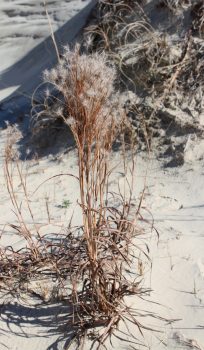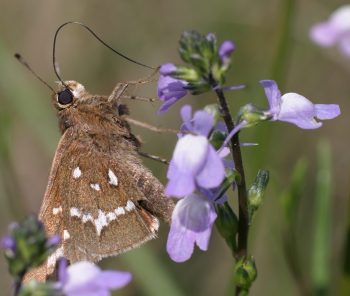
Seaside little bluestem. Photo by Sam Bland.
The North Carolina Coastal Federation’s Ocean office currently has about 100 seaside little bluestem plants available for pickup on a first-come, first-served basis.
If you own beachfront property on Bogue Banks, please consider planting some of these to provide habitat for the crystal skipper, a small brown butterfly found only on the Crystal Coast.
What is seaside little bluestem?
This grassy plant is native to the East Coast and occurs naturally on oceanside dunes.
Where should seaside little bluestem be planted?
Seaside little bluestem can only be planted on the beachfront dunes. Beachfront property owners can plant them within the dunes. They require water after planting but do not need any fertilizer, which can harm them.
Why is it important to plant seaside little bluestem?
These plants are the only habitat for crystal skippers. The butterflies lay their eggs on the plant, and the caterpillars feed on it. Crystal skippers are resistant to the toxins the seaside little bluestem produces to deter other insects.
Due to development, crystal skipper habitat has become fragmented, so planting seaside little bluestem along dunes helps fill in the gaps and increase their habitat.

The crystal skipper. Photo by Sam Bland.
Where did the name come from?
Crystal skippers were first designated as a new species, Atrytonopsis quinteri, in 2015, but it was first collected in 1978. Its name comes from its location and also from the small “crystals,” or white dots, on its wings.
Plants can be picked up for free between 8:30 a.m. and 5 p.m. at 3609 N.C. 24 (Ocean) Newport, NC 28557.
Contact Lexia Weaver with any questions at lexiaw@nccoast.org or 252-393-8185.
